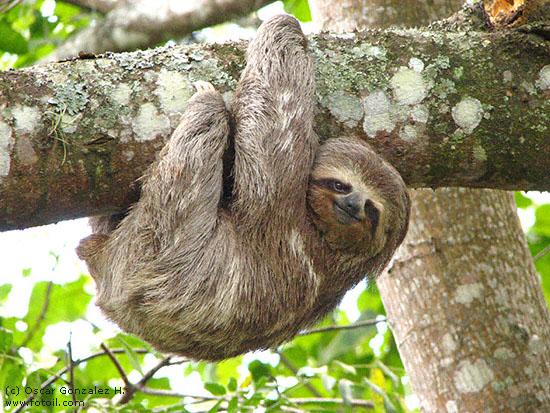Hi kids:
I'm so happy for the people that did the other blog homework ( the food chain game). I really hope you liked it, and most of all, learnt from it. I promise I'll get you more games like this.Now, to our matter.
Remember we talked about the sloths? These great and amazing animals whose most konown trait is their slow motion? I loved the interest you showed on them and... well, here you'll find more information about them! Learn more about these animals and I know that you'll get to admire these creatures as much as I do.
Enjoy!
*********************************************
The sloth is a slow-moving mammal that lives in trees. Sloths spend most of their lives hanging upside-down from tree branches; they eat, sleep, mate, and give birth upside-down in the trees. They hold onto tree branches with strong, curved claws that are on each of their four feet.
Male sloths are solitary, shy animals. Females sometimes congregate together. Sloths are nocturnal; they are most active at night and sleep all day.
SLOTH ANATOMY
Sloths have a thick brown (and slightly-greenish) fur coat. Sloths are about the size of a cat (roughly 2 feet = 61 cm long). They have a short, flat head, big eyes, a short snout, a short or non-existent tail, long legs, and tiny ears. Sturdy, curved claws are on each foot; they use these claws to hang from trees.
Some sloths have colonies of green algae encrusting their fur, both adding to the camouflage effect and providing some nutrients to the sloths, who lick the algae.
NAME
The sloth got its name from its slow movement. It is not lazy, just slow-moving.
DIET
Sloths are plant-eaters who are more active at night; they eat leaves (including leaves from the cecropia tree), tender young shoots, and fruit; they are herbivores (plant-eaters). It used to be thought that sloths ate mostly cecropia leaves because they were often spotted in cecropia trees. It turns out that they also live in many other trees, but aren't spotted there as easily as in cecropia trees.
Sloths have a low metabolic rate and a low body temperature (91°F). This keeps their food and water needs to a minimum. Sloths have small molars which they use to chew up their leafy food. Their stomach has many separate compartments that are used to digest the tough cellulose (a component of plant material that they eat).
SLEEP
Sloths sleep during the day. They sleep about 15 to 18 hours each day, hanging upside down.
PREDATORS
Sloths are hunted by jaguars, harpy eagles, and people. A sloth's main forms of protection are its camouflage (greatly increased by the coating of algae growing on its fur) and its very slow movement; these adaptations make it virtually disappear in the rain forest canopy.
HABITAT AND RANGE
Sloths spend almost all of their lives in trees; they are arboreal. These mostly-quiet mammals live in the tropical rain forests of South and Central America.
LOCOMOTION
The sloth is the slowest mammal on Earth. Sloths are quadrupeds (four-legged animals) who "walk" upside-down along tree branches. They only rarely venture to the ground and walk on the ground in an upright position. Sloths can swim well.
LIFE SPAN
Sloths may live 10-20 years in the wild.
REPRODUCTION
Adult females produce a singe baby each year. They give birth upside down hanging from a tree branch.






5 comentarios:
hello miss i play the game it very cool and i had 12 mistackes bye miss i see you in the school Naany del angel
Miss I play another time another game and I had 5 mistackes
Wow amainsing
Bye.
will algae on a sloths fur affect its life span?
No, actually, colonies of green algae may live in the sloth's fur and provide it with extra camouflage as well as some nutrients, so the algae and the sloth share a form of simbyosis called mutualism, in which both organisms benefit from one another.
Publicar un comentario